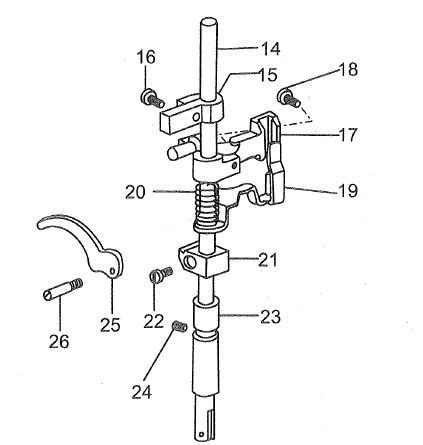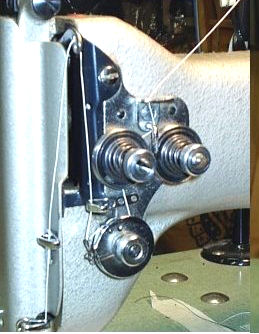-
Posts
5,750 -
Joined
-
Last visited
Content Type
Profiles
Forums
Events
Blogs
Gallery
Everything posted by Constabulary
-

Singer 29K71, Need Help To Evaluate Her
Constabulary replied to b2k's topic in Leather Sewing Machines
65€ is not much for a machine repair, what have they done with it? I think 0.8mm thread is too thick for this machine. The metric thread size should be mention on the thread spool. Patchers are often overrated - they are very versatile but they are not heavy duty machines. Thick thread above 138 (20 metric) does not make much sense with these machines and will probably stress your machine - if you are able to run this thick thread at all. Anyway - check the position of the needle. Sys. 332 needles should have the long grove left and short grove right and the needle eye should face straight right but you can play with it a little bit with the angle. Probably move the needle holder a bit closer to the hook. I´d also check the hook timing and the condition of the hook tip. -
Buy him a new drill press and I´m sure he will "overlook" your new machine
-
Too bad, I just ran out of pocket money. What a damn cool machine! I think with reverse it would cost more Has it a servo or clutch motor?
-
if the pin is not moving at all your tension release slide is probably worn or broken. Part #19 in this picture. LW Member Uwe has a Video on how to replace it.
-
See attached picture - check if the parts are all present (could be be that #15 is missing as not all tension units have this part) especially the pin #11. If pin is present you probably have to adjust the small tab in the center of disc #13 a it towards the machine. It also could be that the pin #20 that goes through the machine is a bit for and does not push against the lever #17 any longer. It also could be that the whole unit is not properly mounted - loosen the screw #22 and push the tension unit a bit towards the machine and tighten the screw again. Screw is inside the machine casting and you see it when you look from the right
-

Help to choose right sewing machine!
Constabulary replied to Gilbert's topic in Leather Sewing Machines
Not "my" Video - Arthur Porter (also a LW member here) made it. -
I have an english 138 manual where the 2 needle sewing thing is mentioned but file its too large to attach. Here is a picture of the "K" marked parts. I only have this tiny picture of the threaded left tension unit - hope this helps
-
The older Pfaff 138 had a stamped in "K" for Knopfloch (thats German for Buttonhole) on the left tension unit and originally the 2nd bobbin case that was supplied with the machine also had a stamped in K. You also can use double needles with this machine f.i. for sewing tucks (in German it is called Biesen) - but don´t ask me how this work's I never tried this. When I had a Pfaff 138 I used the 2nd unit for heavier thread as Ralf C. said.
-
Not sure what you see but for me it looks correctly threaded for a large bobbin hook.
-

Help! Presser foot slamming into feed dog
Constabulary replied to brandyb's topic in Leather Sewing Machines
hard to tell from the distance - can you make a small Video? Is is possible that your feed dog is too high? -
No I don´t - post it please
-
Jimmy where the hell have you found this - Smithsonian again?
-

Temporarily disable Efka EPS?
Constabulary replied to JSLeathercraft's topic in Leather Sewing Machines
I have tried a few clutch motors and 2 other servos before I bought my JACK servo motors and combined them with speed reducers minus the included EPS - I´m pleased and I don´t need anything else but it for sure depends on the individual needs. Others may need am EPS / NPS but I don´t. -

Temporarily disable Efka EPS?
Constabulary replied to JSLeathercraft's topic in Leather Sewing Machines
Sewing fingers hurts and is not heathy in the long view -

Temporarily disable Efka EPS?
Constabulary replied to JSLeathercraft's topic in Leather Sewing Machines
My rather simple JACK servos have an option for using them with and without NPS. I´m using them without as I´m rather slow sewing and simply don´t need it and they do not work in combination with a speed reducer. Just wanted to have this mentioned.. -
I forgot the pictures - send me a PM if you are interested. Registered Airmail to Down Under is approx $8 US
-
I have a complete lever with adjuster screw - are you probably interested?
-
Nice one - good score!
-
@ The Admin - I think its better to move Daves post to a new thread so the things do not mix up. @ Dave I would replace at least the driving pinion too if it is worn. But it could happen that new and used parts in combination bind up the gear box mechanism. You probably have to replace at least the small rack too. But this sometimes is a gamble and depends on how worn certain parts are and how well the new parts are made. The pinions usually have a flat tip teeth. Like this one: http://www.ebay.ca/itm/SINGER-29K-71-SHUTTLE-CARRIER-DRIVING-PINION-82178-/161953006221 So when they are worth they look quite sharp. Here is a sample of badly worn 29K71 pinions
-

Singer 31-15 needle broke, bobbin case problem?
Constabulary replied to horselady21's topic in Leather Sewing Machines
Only the operator knows - this just happens sometimes. I also broke a bunch on needles, Sometimes because I pushed the material too much or made a wired material turn (needle bent and hit the needle plate), too thick needle for too small needle hole, hard spot in the material, hit a piece of hardware (rivet, buckle...)... there are several reasons why a needle could brake. -

Singer 31-15 needle broke, bobbin case problem?
Constabulary replied to horselady21's topic in Leather Sewing Machines
Maybe I dind´t get you... You only have to lower the needle bar when the hit was so hard that the clamped needle bar moved up a bit (needle hook timing thrown off) This has nothing to do with the reason why the needle hit the plate or bobbin case. -

Singer 31-15 needle broke, bobbin case problem?
Constabulary replied to horselady21's topic in Leather Sewing Machines
Could be that your needle hit the needle plate. I´d check the needle bar hight / hook needle timing when you have re assembled everything. You probably have to lower the needle bar a little bit. I think you mean the bobbin case (thing the bobbin rides in) -
as I said - check the tension spring on the shuttle. You probably have to replace it because it is worn. http://www.ebay.com/itm/JAPANESE-SINGER-29K-SHUTTLE-HOOK-TENSION-SPRING-REGULATING-SCREW-8611-662-/321109830405?hash=item4ac3a32b05:m:mmUVSg5GhN1wyzVB8DB3v7w Are you sure you have threaded the machine correctly? Du you have a manual for your machine? Post some good detailed pictures of your threaded machine maybe you did something wrong
-
right, thats the slide plate pin. There should be a small spring too. maybe its still in the hole.
- 20 replies
-
- tacsew t1563
- juki lu-563
- (and 6 more)
-
Agree with Bob but the reverse function is something I would miss. So I would go with the 211 most likely.




